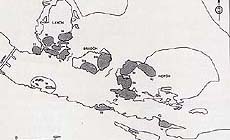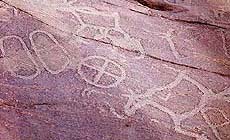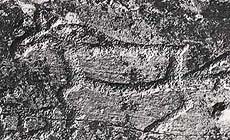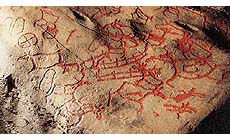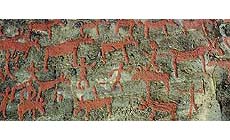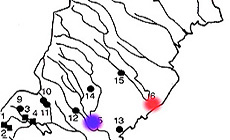|
|
 |
 |
Country: |
Sweden |
Locality: |
Nämforsen: Notön & Brådön |
|
 |
Region: |
Ångermanland |
Area: |
Ådals Lid |
|
 |
 |
|
|
|
|
| |
 |
Environment & Surface |
 |
 |
 |
|
Altitude:
|
80 m
Open-air
Shelter
Cave
Portable
Megalithic
|
Geography: |
The locality of Nämforsen consists of three islands situated in the river, divided into three islands. The carvings are found all over the islands, with the main centre on Notön which is situated closest to the dwellings on the shore of the river. |
Proximity: |
Situated in the river, close to path-ways and trails. |
|
 |
Geology: |
Engraved rocks in the middle of the river, gneiss with natural glacial striations. |
Surface: |
Flat and smooth, light in colour, concave in some cases, rough, cracks, microflora. |
|
|
|
|
 |
 |
|
|
|
|
| |
 |
Art |
 |
 |
 |
Description: |
Engravings
Paintings
Painted engravings
High or low-relief
Sculpture
The locality of Nämforsen consists of three islands, Notön, Laxön and Brådön. The majority of the carvings are found on Brådön and Notön, and together there are more than 1700 figures. Notön has the largest number of engravings, c. 800 figures and Brådön c. 400. The dominant motif is the elk, of which half the number are depicted totally carved out. The other half are contour-carved. Some of the elks are only partly carved out. Most of the ship figures are single-lined with crew-strokes. Other ships are double-lined with vertical lines in the hull. The elk figures with contour-carved bodies sometimes have so called life-lines inside the body, probably showing the heart and lungs of the animal.
|
Figures: |
total number 1200
c. 700 elk figures
c. 366 ship and boat figures
c. 87 human figures
c. 80 angle-shaped figures
34 cup-marks
25 foot soles
19 fish figures
9 bird figures
11-15 so called elk-headed axes or staffs
c. 30 other figures including wheel-crosses
|
|
 |
Chronology: |
Palaeolithic
Epipalaeolithic - Mesolithic
Neolithic
Copper Age
Bronze Age
Iron Age
Roman
Middle Age
Modern
Unknown
Because of the level above the sea at Nämforsen (72-80 mas) the oldest possible dating of the rock carvings will be 4000-3500 BC. Comparisons with motifs from other sites (Alta in Norway; Zalavruga in NW Russia) and also similar levels above the sea supports this. There are dwelling-places all around the site, which have been in use during the summer for a very long period of time, from c. 3000-1000 BC. The majority of the rock carvings seems to have been produced around 2000 BC, and they all belong to the hunter-gatherer tradition.
|
Notes: |
All rock carvings at Nämforsen is usually said to belong to the hunter-gatherer tradition. It is suggested that the carvings were made in the summer and the paintings in the area in the winter. The elk is thought to have been the crucial winter pray, and the carvings depicting these animals were created in rituals aimed at preparing for survival and successful hunting during the hard winter season in interior of Northern Sweden. On the east side of Brådön, the contour-carved elk figure is the dominating motif. |
|
 |
 |
|
| |
 |
Bibliography |
 |
|
|
|
|
| |
 |
Conservation |
 |
 |
 |
Status: |
Public
Private
Park
Classified site
|
Risk: |
The river were expanded when a water-power station were built, and the water level became higher, threatening to cover the well-known rock carving environment. The carvings are subjected to natural natural weathering (mechanical weathering) during winter/spring, when water freeze in cracks and openings in the rock, creating major damage to rock faces with rock art. |
|
 |
Conservation: |
Good
Quite good
Mediocre
Bad
|
Intervention: |
The damm were placed in such a way that most of the carvings were rescued from being covered by the water. |
|
 |
 |
|
|
 |
By |
 |
|
| |
| Record n. 802 / 807 |
No commercial use is allowed. Specific © is mentioned in the captions or owned by each Author or Institution |
|
| |
 |
EuroPreArt, European Prehistoric Art, is a web-based archaeological project funded by the European Union which aims to establish a lasting data-base of European prehistoric art documentation, to launch the base of an European institutional network and to contribute to the awareness of the diversity and richness of European Prehistoric Art.
It is proposed by: Instituto Politécnico de Tomar (IPT, Portugal),
CUEBC - European University Centre for Cultural Heritage (Italy - Europe),
Consejo Superior de Investigaciones Científicas (España),
Asociación Cultural Colectivo Barbaón (España),
Université de Liège (Belgique),
Gotland University College (Sverige),
University College Dublin (Eire),
Cooperativa Archeologica Le Orme dell'Uomo (Italia),
Study Centre and Museum of Prehistoric Art of
Pinerolo (Italia),
The European Centre for Prehistoric Research in the Alto Ribatejo (Portugal),
ArqueoJovem - a youth NGO (Portugal).
|
|
|
|
 |
|
 NEW: Alpine rock paintings
NEW: Alpine rock paintings